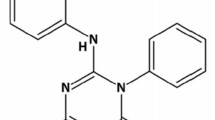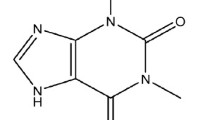Summary
The aim of the present study was to investigate an eventual influence of the hour of administration on lidocaine kinetics in the rat. 280 Wistar AF-SPF adult male rats were used for this study and maintained under controled environmental conditions (LD : 06.00–18.00) during the month of October. A single 50 mg.kg−1 dose of lidocaine was given by intramuscular route, at four different fixed time points of a 24 hour period (i.e.: 10.00, 16.00, 22.00 and 04.00) to 70 rats. Blood samples were taken at the following time points: 5, 15, 30 min., 1, 2, 4 and 6 hours after the drug administration. Lidocaine plasma levels (free and bound) were determinated according to a specific gas chromatographic method.
The data showed circadian variations of pharmacokinetic parameters: — Elimination half-life: max. 2.12 ±0.05 h at 10.00, min. 1.50± 0.03 h at 16. — Initial concentration: max. 5.05±0.65 μg.m1−1 at 16.00; min. 2.97±0.29 μg.ml−1 at 04.00. — Elimination constant rate: max. 0.4618±0.0094 h−1 at 16.00, min. 0.3279±0.0079 h−1 at 10.00. — Area under curve (experimental): max. 11.11 ±1.07 μg.kg−1.h−1 at 16.00, min. 7.45±0.84 μg.kg−1.h−1 at 04.00. — Apparent volume of distribution: max. 16.67±1,67 L.kg−1 at 04.00, min. 9.75±1.04 L.kg−1 at 16.00.
The lidocaine-free fraction varied with time and the protein binding of lidocaine showed a circadian variation.
The observed variations may be related to ( 1 ) daily fluctuations of absorption or binding of the drug (2) to diurnal variation of the hepatic drug metabolising enzymes responsible for the inactivation of the drug and/or (3) to diurnal variations in excretion rate of lidocaine.
Finally, the results agree with those of Lutsch and Morris who found a circadian periodicity in susceptibility to lidocaine in the mouse with maximal convulsant activity at 21.00.
Similar content being viewed by others
References
Reinberg A., Halberg F. (1971): Circadian chronopharmacology. Ann. Rev. Pharmacol.,11, 455–492.
Bouyard P., Bruguerolle B., Jadot G., Mesdjian E., Valu M. (1974): Mise en évidence d’un rythme nycthéméral dans le phénomène de la curarisation chez le rat. CR. Soc. Biol.,168, 1005–1007.
Bruguerolle B., Valu M., Jadot G., Bouyard P. (1982): Chronobiologie, chronopharmacologie, chronopharmacocinétique et chronothérapie. In «Actualités de Chimie Thérapeutique», 9ème série, Lavoisier, Paris, pp. 103–121.
Lutsch E.F., Morris R.W. (1967): Circadian periodicity in susceptibility to lidocaine hydrochloride. Science,156, 100–102.
Reinberg A., Reinberg M.A. (1977): Circadian changes of the duration of action of local anaesthetic agents. Naunyn-Schmiedeberg’s Arch. Pharmacol.,297, 149–152.
Kline B.J., Martin M.F. (1978): Simplified GLC assay for lidocaine in plasma. J. Pharm. Sei.,67, 887–888.
Jadot G., Bruguerolle B., Valli M., Bouyard P. (1980): Détermination rapide de la fraction plasmatique libre des substances médicamenteuses. Ann. Biol. Clin.,38, 379–380.
Gomeni C., Gomeni R. (1978) Igpharm: Interactive graphie package for pharmacokinetics analysis. Computer Biomed. Res.,11, 345–361.
Njus D., Sulzman F.M., Hastings T.W. (1974): Membrane model for the circadian clock. Nature,248, 116–120.
Evans E.F., Proctor J.D., Fratkin M.J., Velandia J., Wassermann A.J. (1974): Blood flow in muscle groups and drug absorption. Clin. Pharmacol. Therap.,17, 44–47.
Collinsworth K.A., Kaiman S.M., Harrison D.C. (1974): The clinical pharmacology of lidocaine as an antiarrhythmic drug. Circulation,50, 1217–1230.
Bruguerolle B., Valli M., Jadot G., Bouyard L., Bouyard P. (1980): Influence of the hour of administration on free carbamazepine plasma levels. Comm. XlVe Rencontres Intern, de Chimie Thérapeutique, Marseille, Abstract no C4.
Valli M., Jadot G., Bruguerolle B., Bussiere H., Bouyard P. (1979): Variations circadiennes des protéines plasmatiques chez le rat mâle adulte en synchronisation naturelle. J. Physiol. (Paris),75, 811–814.
Hollunger G. (I960): On the metabolism of lidocaine. II. The biotransformation of lidocaine. Acta Pharmacol. (Kobenhavn),17, 365–370.
Jori A., Salle D., Santini V. (1971): Daily rhythmic variation and liver drug metabolism in rats. Biochem. Pharmacol.,20, 2965–2969.
Nair V., Casper R. (1969): Influence of light on daily rhythm in the hepatic drug metabolizing enzymes in rat. Life Sciences,8, 1291–1298.
Radzialowski F.M., Bousquet W.F. (1968): Daily rhythmic variation in hepatic drug metabolism in the rat and mouse. J. Pharmacol, exptl. Therap.,163, 229–238.
Müller O. (1974): Circadian rhythmicity in response to barbiturates. (In) Chronobiology, ed. by L.E. Scheving, F. Halberg, J.E. Pauly, Stuttgart, Georg Thieme publ., pp. 187–190.
Thomson P.D., Rowland M., Melmon K.L. (1971): The influence of heart failure, liver disease and renal failure on the disposition of lidocaine in man. Am. Heart J.,82, 417–428.
Stenson R.E., Constantino R.T., Harrison D.C. (1971): Interelationship of hepatic blood flow, cardiac output, and blood levels of lidocaine in man. Circulation,43, 205–215.
Benowitz N., Rowland M., Forsyth R., Melmon K.L. (1973): Circulatory influence of lidocaine disposition. Clin. Res.,21, 467.
Cambar J., Lemoigne F., Toussaint C. (1979): Diurnal variations of glomerular filtration in the rat. Experientia,35, 1607–1608.
Author information
Authors and Affiliations
Rights and permissions
About this article
Cite this article
Bruguerolle, B., Valli, M., Bouyard, L. et al. Effect of the hour of administration on the pharmacokinetics of lidocaine in the rat. European Journal of Drug Metabolism and Pharmacokinetics 8, 233–238 (1983). https://doi.org/10.1007/BF03188753
Received:
Issue Date:
DOI: https://doi.org/10.1007/BF03188753




